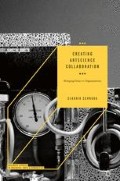Abstract
Artscience collaboration initiatives and centers that focus on interdisciplinary exchange between art and science are growing around the world. Hubs at universities like the MIT Media Lab, SymbioticA at the University of Western Australia, or the Art|Sci Center at UCLA became role models for newly established centers and departments at universities. The Leonardo group is growing, and Leonardo events and talk series spread after the 50th anniversary of Leonardo even further, and hubs for exchange and meeting like Le Laboratoire and The Laboratory at Harvard are founded around the world. Initiatives like a2ru (Alliance for the Arts Research Universities) in the US map and support such centers, funding opportunities, and educational programs that include art in scientific research and education. In Europe the European Commission supports artists in scientific projects through the STARTS grant; in addition, many smaller individual grant opportunities are developing right now and artscience festivals, galleries, museums, and exhibitions are rapidly growing and spreading, like Ars Electronica and Science Gallery, two institutions that start initiatives around the world. The opportunities in the artistic and scientific field are growing worldwide; it is barely possible to name them all. At the same time, after a long absence since the 1960s, since Xerox PARC created the artist-in-residence program PAIR in the 1990s, the number of corporations inviting artists and supporting artist-in-residence programs seems to be growing exponentially. And those experiencing these collaborations and programs—if done well—understand how important this process is for them and their organization. The interest is growing, and in recent months, initiatives (e.g., festivals, residency programs, exchange programs, intermediary organizations, artscience centers, cultural hubs) have been started more and more frequently based on the positive experiences and high expectations in artscience collaboration.
Access this chapter
Tax calculation will be finalised at checkout
Purchases are for personal use only
References
Benson, M. H., Lippitt, C. D., Morrison, R., et al. (2015). Five Ways to Support Interdisciplinary Work Before Tenure. Journal of Environmental Studies and Sciences, 6(2), 260–267.
Catts, O., & Zurr, I. (2018). Artists Working with Life (Sciences) in Contestable Settings. Interdisciplinary Science Reviews, 43(1), 40–53.
Clark, B., & Button, C. (2009). Sustainability Transdisciplinary Education Model: Interface of Arts, Science, and Community (STEM). International Journal of Sustainability in Higher Education, 12(1), 41–54.
de la Garza, A., & Travis, C. (Eds.). (2019). The STEAM Revolution. Transdisciplinary Approaches to Science, Technology, Engineering, Arts, Humanities, and Mathematics. Cham: Springer.
Dewey, J. (1934). Art as Experience. New York: Minton, Balch and Company.
Goldman, K. H., Yalowitz, S., & Wilcox, E. (2016). The Impact of Arts-Based Innovation Training on the Creative Thinking Skills, Collaborative Behaviors and Innovation Outcomes of Adolescents and Adults. Research Study Report Art of Science Learning (Harvey Seifter, Principal Investigator).http://www.artofsciencelearning.org/wp-content/uploads/2016/08/AoSL-Research-Report-The-Impact-of-Arts-Based-Innovation-Training-release-copy.pdf
Jacobson, S. K., Seavey, J. R., & Mueller, R. C. (2016). Integrated Science and Art Education for Creative Climate Change Communication. Ecology and Society, 21(3), 30.
Klein, J. T. (2006). Afterword: The Emergent Literature on Interdisciplinary and Transdisciplinary Research Evaluation. English Faculty Research Publications. Paper 4. http://digitalcommons.wayne.edu/englishfrp/4
Klein, J. T., & Falk-Krzesinski, H. (2017). Interdisciplinary and Collaborative Work: Framing Promotion and Tenure Practices and Policies. Research Policy, 46, 1055–1061.
Root-Bernstein, R., Pathak, A., & Root-Bernstein, M. (2017). Review of Studies Demonstrating the Effectiveness of Integrating Arts, Music, Performing, Crafts and Design into Science, Technology, Engineering, Mathematics and Medical Education. Part 1, Part 2, Part 3. White Paper.
Shanken, E. A. (2005). Artists in Industry and the Academy: Collaborative Research, Interdisciplinary Scholarship and the Creation and Interpretation of Hybrid Forms. Leonardo, 38(5), 415–418.
Steyaert, C., Beyes, T., & Parker, M. (2017). The Routledge Companion to Reinventing Management Education. Abingdon: Routledge.
Wong, D. (2007). Beyond Control and Rationality: Dewey, Aesthetics, Motivation, and Educational Experience. Teachers College Record, 109(1), 192–220.
Author information
Authors and Affiliations
Corresponding author
Rights and permissions
Copyright information
© 2019 The Author(s)
About this chapter
Cite this chapter
Schnugg, C. (2019). Outlook. In: Creating ArtScience Collaboration. Palgrave Studies in Business, Arts and Humanities. Palgrave Macmillan, Cham. https://doi.org/10.1007/978-3-030-04549-4_13
Download citation
DOI: https://doi.org/10.1007/978-3-030-04549-4_13
Published:
Publisher Name: Palgrave Macmillan, Cham
Print ISBN: 978-3-030-04548-7
Online ISBN: 978-3-030-04549-4
eBook Packages: Business and ManagementBusiness and Management (R0)

